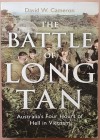The Battle of Long Tan: Australia’s four hours of hell in Vietnam
Written by: David W. Cameron
Penguin Random House Australia, 2017, 392pp,
Reviewed by: Major Lindsay Amner
Military history is generally written by the winners. If the losers write their version of history, they will generally add a bit of glory to their actions so they appear glorious losers rather than just losers. But whichever side writes the history, it is generally told from only one side, from the cultural perspective of the writer. David Cameron attempts to correct this and his military history books are generally written with an attempt to show both sides of the story, or at least to include the perspective of the other side.
The Battle of Long Tan in 1966 lasted a bit over four hours—and most Australians will have heard of it, in this the 50th anniversary year—as it has become the most famous Australian action of the Vietnam War. Boiled down, the story we know is that 105 Australians and three New Zealanders bumped into more than 2000 Viet Cong and fought a desperate battle in the Long Tan rubber plantation. By the end of the battle, the Australians were pulled back in all round defence of the New Zealand artillery observation officer as he called in the constant rain of artillery fire which won the battle, for the loss of 18 Australian soldiers’ lives.
As the winners, Australia wrote the history and every history written of the battle so far has largely focused on the Australians; and in large part, on the controversy which followed as the winners’ efforts were not recognised with medals. The lack of a Vietnamese viewpoint is partly because of the difficulty in getting any good research done in Communist Vietnam. But in this book David Cameron has attempted to show what the Vietnamese were thinking and doing, before, during and after the action. In this he has been moderately successful. While there are still gaps from the Vietnamese side, this is the best attempt yet to show a balanced view of the action, including testimony from Vietnamese who took part in the battle, alongside the numerous personal accounts from Australians interviewed by the author.
The book also includes an excellent potted history of the Australian involvement in Vietnam and a detailed retelling of the events which led to the actual battle. It includes some criticism directed at senior Australian commanders who appeared to believe what they wanted to believe—of small scale local attacks, rather than the possibility of an enemy regiment moving into their area in strength, which a more open-minded approach to the intelligence may have indicated.
David Cameron has written an interesting and engaging book, the most- balanced account yet written of the Battle of Long Tan and well worth a read.

